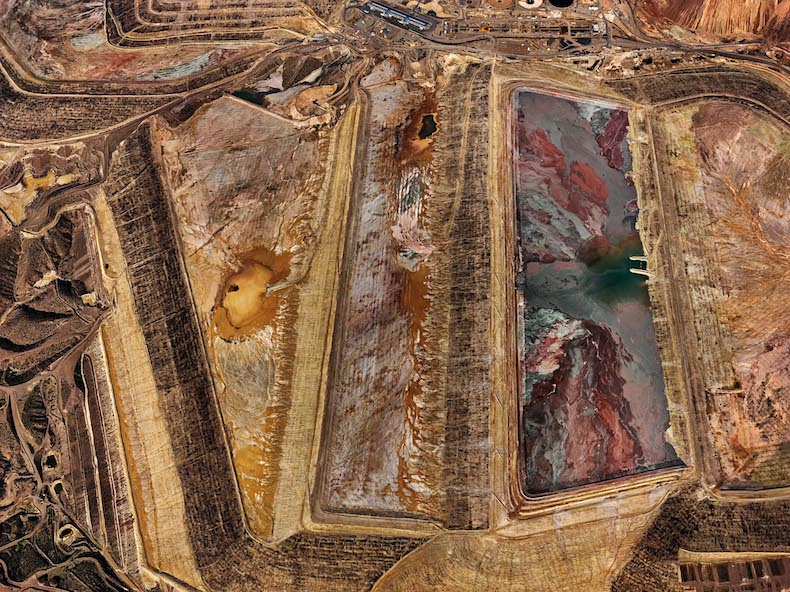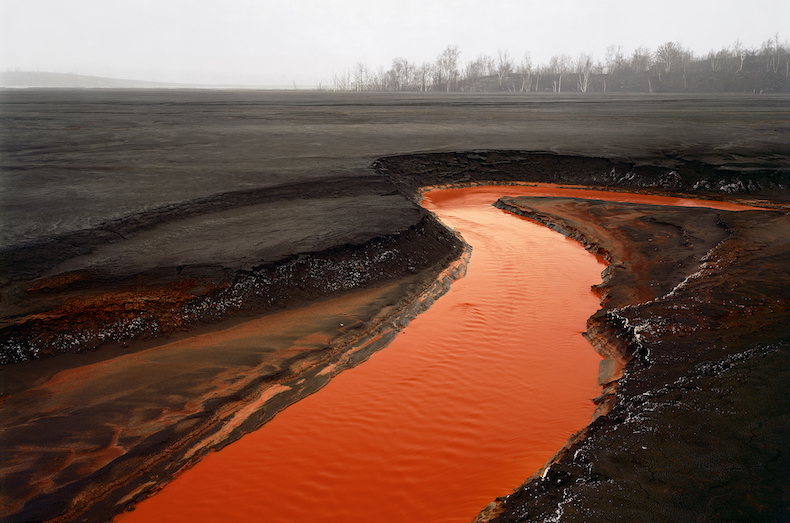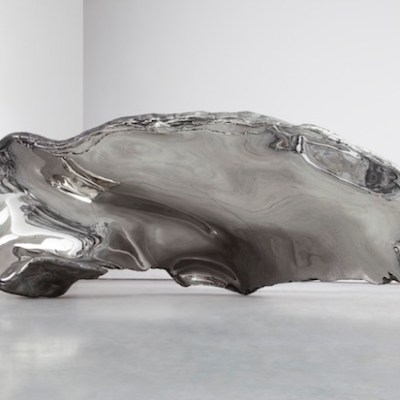Crawford Lake is around an hour’s drive from Toronto, home of the photographer Edward Burtynsky. Scientists studying sediment layers in the lake have found samples of plutonium from hydrogen bomb tests, carbon particles from fossil fuel burning and nitrates from the mass application of chemical fertilisers. Some want the lake to become an international reference point marking the dawn of the Anthropocene – the period when the human species began to alter the planet irrevocably, becoming a geological force comparable to immense volcanic eruptions or the variations in the Earth’s orbit that drive glacial cycles.
Like these scientists, Burtynsky has long been fascinated by the effects of large-scale human activity on the landscape, especially industry and agriculture. His Anthropocene series (2012–17) and accompanying documentary of 2018 did much to popularise the term beyond the scientific community, and ‘Abstraction/Extraction’ – his sumptuous, thoughtful new retrospective at the Saatchi Gallery – continues this line of inquiry.
We begin with abstraction. A mosaic of jewel-like blobs and geometric shapes recalls the work of Gustav Klimt. It’s only after reading the accompanying text that you realise these are salt ponds near Fatick in Senegal. Elsewhere a mass of amoeba-like silvered shapes decorated with charcoal lines appear to be quoting the work of Jean Dubuffet, though are actually an example of dryland farming in the county of Monegros in north-eastern Spain. In the first three galleries the pieces are mostly landscapes shot from above – often from a drone or Cessna plane. At first glance the curiously flattened perspective, typically with no markers of scale, deliberately obfuscates. One work shows translucent blues and greens bisected by golden lines, like a modernist stained glass window (Cerro Prieto Geothermal Station #2, Sonora, Mexico, 2012). Another a panel of coppers and bronzes, layers of gold stacked up like the pages of a book and drifts of pink and deep maroon (Morenci Mine #2, Clifton, Arizona, USA, 2012). Much here is so very, very beautiful.
Morenci Mine #2, Clifton, Arizona, USA, 2012 (2012), Edward Burtynsky. Courtesy Flowers Gallery; © Edward Burtynsky

But this beauty is dangerous. The copper mine in Arizona contaminates local water sources. Dryland farming in Aragon is destroying the region’s unique flora and fauna. The Mexican geothermal station has been associated with an increase of health complaints from locals breathing in the briny vapours. The works in ‘Abstraction/Extraction’ provoke unease as well delight. What does it mean to have an aesthetically pleasurable response to something so damaging?
Burtynsky’s father worked in a car factory, dying of cancer at the age of 45 as a result of exposure to electrical insulating oils. As a young man Burtynsky himself worked in both factories and mines – industries he has continued to photograph throughout his career. Later in the exhibition the pictures become more straightforwardly legible. There are sections devoted to mining, quarrying, farming, factories and immense landfill sites. In Nickel Tailings #34 & #35, Sudbury, Ontario, Canada, 1996 a contaminated river the colour of molten lava curves through an empty landscape of flat, blackened earth. In the distance leafless trees are barely visible against a white, misty sky. It is at once desolate and ravishing – the epitome of the industrial sublime.
Nickel Tailings #34 & #35, Sudbury, Ontario, Canada, 1996 (1996), Edward Burtynsky. Courtesy Flowers Gallery; © Edward Burtynsky

Burtynsky has said that he sees his photographs as neither ‘endorsements or indictments’. Instead, he talks about ‘pulling the curtain away’ to show the ‘other world that has to be there, for this world to exist’. Here is a picture of an oilfield like the one that produced the petrol for your car. Here are the desert processing plants where the lithium in your phone came from. Here is where the granite from your kitchen counter was hacked from the Earth. All of this is what it takes to sustain your life, and aesthetic beauty is the bait that Burtynsky uses to draw us in.
There is variety here. Some images celebrate human ingenuity, such as a photograph of rows of curving, shimmering rice terraces in Yunnan Province, China, or glowing blocks of crushed metal awaiting recycling in Ontario. But walking back through the early galleries, where much of the strongest work in the exhibition is found, it was the emptiness of the landscapes that I noticed. In Burtynsky’s vast aerial shots, humans are either absent or too small to register. Look closely and you might find a tiny building, a speck of a bright stationary excavator, but no figures. After a while the work began to feel like both a record of what we are doing now and an eerie forecast – the future of a planet no longer habitable. Burtynsky’s photographs are, as W.G. Sebald wrote about the former nuclear testing site Orford Ness, like finding oneself ‘amidst the remains of our own civilization after its extinction in some future catastrophe’.
Salinas #2, Cádiz, Spain, 2013 (2013), Edward Burtynsky. Courtesy Flowers Gallery, London; © Edward Burtynsky

Judeo-Christian tradition once placed humans comfortably at the centre of Creation. Then Copernicus, Darwin and others showed us this was not so. Perhaps the concept of the Anthropocene – first popularised in 2000 and spreading with astonishing speed from the sciences to the arts and into wider society – has proved so compelling because, in a sense, it puts us back at the centre of the world.
Burtynsky’s photographs suggest that at some level we can’t help finding that idea attractive and thrilling – even if the price is environmental disaster. And perhaps finally it is this queasy, unspoken knowledge that most unsettles in the Saatchi show. Gaping, we stroll past Burtynsky’s photographs of our triumph rocked by the beauty and the horror.
Burtynsky: Extraction/Abstraction is at the Saatchi Gallery, London, until 6 May; ‘Edward Burtynsky – New Works’ is at Flowers Gallery, London, until Apr 6.



